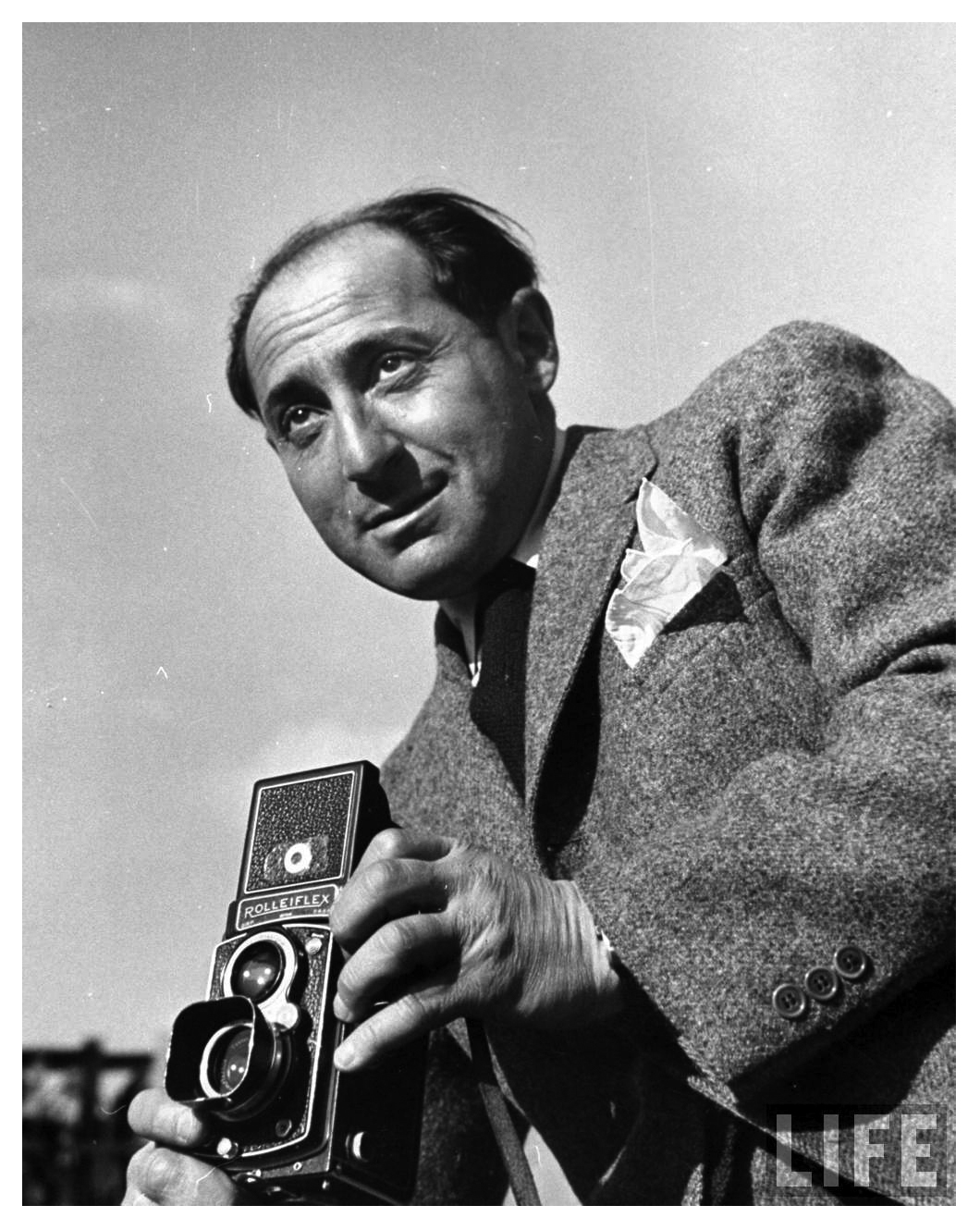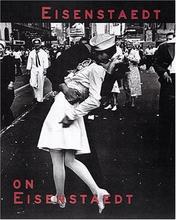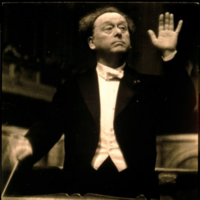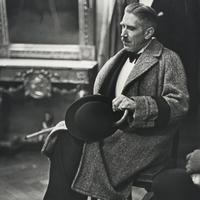More about Alfred Eisenstaedt
- All
- Info
- Shop
Works by Alfred Eisenstaedt

Contributor
You know the famous photo of the sailor kissing the nurse in Times Square in 1945, after the Americans won the war?
This is the guy who took it. He also did the portraits of Marilyn Monroe, Albert Einstein, and so many other figures of the 20th century.
Eisenstaedt served in the German Army from 1916-1918 during World War I, from which he sustained injuries in both legs. Following his leave, he worked as a button and belt salesman in Berlin. At this point in time, Eisenstaedt felt he no longer wanted to press holes into leather, but instead press shutter buttons to make photographs. He taught himself photography, got really into it, and became a freelance photojournalist. In 1929, he got his first assignment covering the Nobel Prize in Stockholm and with it earned his first keep as a professional photographer.
His single-minded devotion to the craft helped him rack up an impressive resume of clients and subjects. From 1929-1935 he worked for the Pacific and Atlantic Picture Agency, the Associated Press, and the Berliner Illustrierte Zeitung. He covered Hitler’s rise to power and documented Ethiopia before the Italian invasion. By his immigration to the United States in 1935, he had freelanced for Harper's Bazaar, Vogue, Town and Country. He was hired by Henry Luce as one of the first four photographers working on LIFE Magazine in 1936, alongside Margaret Bourke-White, Peter Stackpole, and Thomas McAvoy. He remained there for forty years, covering every historic moment from then until his retirement as its leading photographer. From kings to paupers, Eisenstaedt did it all.
For the photography nuts out there, he was an avid user of a 35-mm Leica, which was his body of choice for over 2500 photo essays and nine cover pages. Probably part of the reason why these cameras cost an arm and a leg now.
Sources
- Hostetler, Lisa. 2018. “Alfred Eisenstaedt.” International Center of Photography. International Center of Photography. December 22, 2018. https://www.icp.org/browse/archive/constituents/alfred-eisenstaedt?all/….

Contributor
Alfred Eisenstaedt is the photographer who captured the most famous account of sexual assault in the country - Victory over Japan Day, August 14, 1945.
Born in 1898 Dirschau, West Prussia, what is now Tczew, Poland, Eisenstaedt (“Eisie” as his friends call him) was taking pictures by the time he was a wee lad of 14. But then World War I started so Eisie fought for the German army right up until he was Swiss cheesed with shrapnel during a British attack. He almost lost both of his legs and was the only man in his battalion to survive. This had to have built up some great karma, so you know something good was about to come his way.
This was not that case. After he almost died and lost all of his friends, his family’s business went under during the post-war economic decline. And on top of that, Eisie had to resort to selling buttons and belts for 10 years to support himself. Only then did good Karma finally decided to grace Eisie with her presence. When the new Ermanox camera came out, Eisie was of the “treat yo' self” school of thought and bought it. One of his first pictures was of a woman playing tennis and he sold it to a German weekly for $3. When Eisie figured out that he could make money taking pictures, he ditched his boring job despite his boss’ warning that he was “digging his own grave.”
Things were definitely shaky at first - Eisie was hired to photograph a famous wedding in Italy but forgot to photograph the bride and groom. But he got it together eventually and photographed even the most difficult subjects. Ernest Hemingway once told him that if he got closer than 200 feet from him, he’d shoot him. And when Alfred inevitably got closer than 200 feet to Papa, he really did shoot at him! Perhaps even scarier than being shot at by Papa was Eisie’s portrait of a scowling Joseph Goebbels, the Nazi Minister of Propoganda (especially because Eisenstaedt was Jewish). And then he also photographed Marilyn Monroe, because who didn’t in those days? By the end of his career Eisie was one of the most prominent photographers Life Magazine had ever had.
Sources
- "Alfred Eisenstaedt Facts, Information, Pictures | Encyclopedia.Com Articles About Alfred Eisenstaedt." Encyclopedia.com. N.p., 2004. Web. 29 Aug. 2017.
- Cosgrove, Ben. "'Hemingway Almost Killed Me': A LIFE Photographer Remembers." Time.com. N.p., 2014. Web. 1 Sept. 2017.
- Cosgrove, Ben. "Behind The Picture: Joseph Goebbels Glares At The Camera, Geneva, 1933." Time.com. N.p., 2014. Web. 1 Sept. 2017.
- Hagen, Charles. "Alfred Eisenstaedt, Photographer Of The Defining Moment, Is Dead At 96." Nytimes.com. N.p., 1995. Web. 1 Sept. 2017.
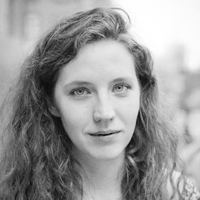
Contributor
You may not know his name, but you definitely know his work.
Let’s just get the big one out of the way: he snapped the famous-yet-rapey V-J Day, The Kiss. You know, that photo that’s a poster on countless dorm room walls, showing a WWII sailor aggressively kissing a nurse who, upon closer inspection, doesn’t seem to be having a great time. The moment was a celebration of the US’s victory against Japan, and Time Magazine called it one of the ten greatest images in the history of photojournalism. Barf.
Eisenstaedt (known to friends as “Eisie”), was Polish born and German bred. He moonlighted as a self-taught photographer while working as a button and belt salesman in Berlin. His first real gig was photographing the 1929 Nobel Prize ceremony in Stockholm. Eisie was regarded as a man who could make a compelling photo out of anything or anyone. After he fled Nazi Germany in the ‘30s, his reputation earned him a spot as one of four staff photographers for Life Magazine, where he worked for 40 years until well into his 90s.
He traveled the world capturing scenes as grim as Hitler and Mussolini shaking hands, as whimsical as an ice skating waiter at the Grand Hotel in St. Moritz, Switzerland, and as adorable as a bunch of French children losing their freaking minds at a Paris puppet show.
He took risks in his work. After Life published his 1964 photograph of Sophia Loren wearing *quite* an outfit, the magazine received 2,500 angry letters and 800 cancelled subscriptions. On a visit to Havana in 1952 to photograph Ernest Hemingway, the notorious drunkard tried to rough Eisie up in a tussle over whether or not Hemingway had tried to shoot at Eisenstaedt’s boat during a fishing contest that morning. But Eisie, a small, dapper gentleman about 5’ 4” in stature, wasn’t easily perturbed. During his career he saw it all and was known to have said, “If I have a camera in my hand, I don’t know fear.”
Sources
- “Artist Alfred Eisenstaedt.” International Center of Photography. Accessed August 27, 2017. https://www.icp.org/browse/archive/constituents/alfred-eisenstaedt?all/…
- “Bless ‘Em All, the Young, Short and Tall.” Life Magazine. Vol. 37, No. 8. August 23, 1954.
- Chalasani, Radhika. “Famed Life Photographer Alfred Eisenstaedt.” CBS News. Accessed August 27, 2017. https://www.cbsnews.com/pictures/alfred-eisenstaedt-legendary-life-maga…
- Cosgrove, Ben. “‘Hemingway Almost Killed Me’: A Life Photographer Remembers.” Time. July 20, 2014. Accessed August 27, 2017. http://time.com/3880529/hemingway-almost-killed-me-a-life-photographer-…
- Cosgrove, Ben. “Unforgettable Eisenstaedt: 22 Amazing Photos by a Master.” Time. November 3, 2014. Accessed August 27, 2017. http://time.com/3491299/unforgettable-eisenstaedt-22-amazing-photos-by-…
- Grundberg, Andy. “Alfred Eisenstaedt, 90: The Image of Activity.” The New York Times. November 12, 1988. Accessed August 27, 2017. http://www.nytimes.com/1988/11/12/arts/alfred-eisenstaedt-90-the-image-…
- Levy, Claudia. “Alfred Eisenstaedt, 96, Dies.” The Washington Post. August 25, 1995. Accessed August 27, 2017. https://www.washingtonpost.com/archive/local/1995/08/25/alfred-eisensta…
- Marien, Mary Warner. “Photography: A Cultural History.” Laurence King Publishing. 2006.
Featured Content
Here is what Wikipedia says about Alfred Eisenstaedt
Alfred Eisenstaedt (December 6, 1898 – August 23, 1995) was a German-born American photographer and photojournalist. He began his career in Germany prior to World War II but achieved prominence as a staff photographer for Life magazine after moving to the U.S. Life featured more than 90 of his pictures on its covers, and more than 2,500 of his photo stories were published.
Among his most famous cover photographs was V-J Day in Times Square, taken during the V-J Day celebration in New York City, showing an American sailor kissing a nurse in a "dancelike dip" which "summed up the euphoria many Americans felt as the war came to a close", in the words of his obituary. He was "renowned for his ability to capture memorable images of important people in the news" and for his candid photographs taken with a small 35mm Leica camera, typically with natural lighting.
Check out the full Wikipedia article about Alfred Eisenstaedt

